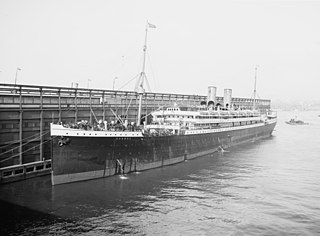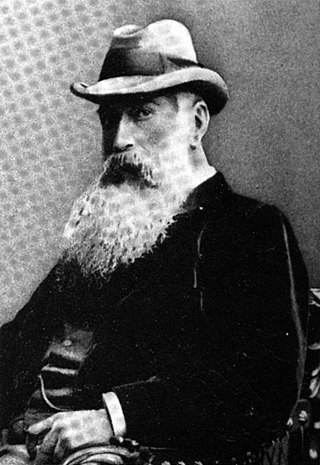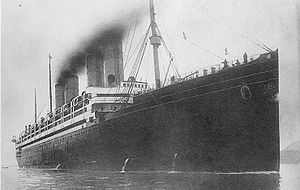
Kaiser Wilhelm der Grosse was a German transatlantic ocean liner in service from 1897 to 1914, when she was scuttled in battle. She was the largest ship in the world for a time, and held the Blue Riband until Cunard Line’s RMS Lusitania entered service in 1907. The vessel’s career was relatively uneventful, despite a refit in 1913.

The Blue Riband is an unofficial accolade given to the passenger liner crossing the Atlantic Ocean in regular service with the record highest average speed. The term was borrowed from horse racing and was not widely used until after 1910. The record is based on average speed rather than passage time because ships follow different routes. Also, eastbound and westbound speed records are reckoned separately, as the more difficult westbound record voyage, against the Gulf Stream and the prevailing weather systems, typically results in lower average speeds.

An ocean liner is a type of passenger ship primarily used for transportation across seas or oceans. Ocean liners may also carry cargo or mail, and may sometimes be used for other purposes. Only one ocean liner remains in service today.

RMS Mauretania was a British ocean liner designed by Leonard Peskett and built by Wigham Richardson and Swan Hunter on the River Tyne, England for the Cunard Line, launched on the afternoon of 20 September 1906. She was the world's largest ship until the launch of RMS Olympic in 1910. Mauretania captured the eastbound Blue Riband on the maiden return voyage in December 1907, then claimed the westbound Blue Riband for the fastest transatlantic crossing during her 1909 season. She held both speed records for 20 years.

SS Kaiser Wilhelm II was a Norddeutscher Lloyd (NDL) Kaiser-class ocean liner. She was launched in 1902 in Stettin, Germany. In the First World War she was laid up in New York from 1914 until 1917, when the US Government seized her and renamed her USS Agamemnon. In 1919 she was decommissioned from the Navy and laid up. In 1927 she was transferred to the United States Army, who renamed her USAT Monticello. She was scrapped in 1940.
Norddeutscher Lloyd was a German shipping company. It was founded by Hermann Henrich Meier and Eduard Crüsemann in Bremen on 20 February 1857. It developed into one of the most important German shipping companies of the late 19th and early 20th centuries, and was instrumental in the economic development of Bremen and Bremerhaven. On 1 September 1970, the company merged with Hamburg America Line (HAPAG) to form Hapag-Lloyd AG.
Aktien-Gesellschaft Vulcan Stettin was a German shipbuilding and locomotive building company. Founded in 1851, it was located near the former eastern German city of Stettin, today Polish Szczecin. Because of the limited facilities in Stettin, in 1907 an additional yard was built in Hamburg. The now named Vulcan-Werke Hamburg und Stettin Actiengesellschaft constructed some of the most famous civilian German ships and it played a significant role in both World Wars, building warships for the Kaiserliche Marine and the Kriegsmarine later.

Kronprinz Wilhelm was a German ocean liner built for Norddeutscher Lloyd, a shipping company now part of Hapag-Lloyd, by the AG Vulcan shipyard in Stettin, Germany, in 1901. She was named after Crown Prince Wilhelm, son of the German Emperor Wilhelm II, and was a sister ship of SS Kaiser Wilhelm der Grosse.

SS France was a French transatlantic liner that sailed for the Compagnie Générale Transatlantique (CGT), known as "French Line". She was later nicknamed "Versailles of the Atlantic", a reference to her décor which reflected the famous palace outside Paris. Ordered in 1908, she was introduced into the Transatlantic route in April 1912, just a week after the sinking of RMS Titanic, and was the only French liner among the famous four-funnel liners. France quickly became one of the most popular ships in the Atlantic. Serving as a hospital ship during World War I, France would have a career spanning two decades. Her overall success encouraged CGT to create even larger liners in the future.

SS Deutschland was a passenger liner built in Stettin and launched on 10 January 1900 for the Hamburg America Line (HAPAG) of Germany. She was officially the second ocean liner to have four funnels on the transatlantic route, the first being Kaiser Wilhelm der Grosse of 1897.

SS Kronprinzessin Cecilie was an ocean liner built in Stettin, Germany in 1906 for North German Lloyd that had the largest steam reciprocating machinery ever fitted in a ship. The last of four ships of the Kaiser class, she was also the last German ship to have been built with four funnels. She was engaged in transatlantic service between her home port of Bremen and New York until the outbreak of World War I.

The SS Bremen, later renamed Constantinople and then King Alexander, was a German Barbarossa class ocean liner commissioned in 1897 by Norddeutscher Lloyd.

RMS Campania was a British ocean liner owned by the Cunard Line, built by Fairfield Shipbuilding and Engineering Company of Govan, Scotland, and launched on Thursday, 8 September 1892.

The Olympic-class ocean liners were a trio of British ocean liners built by the Harland & Wolff shipyard for the White Star Line during the early 20th century. They were Olympic (1911), Titanic (1912) and Britannic (1914). All three were designed to be the largest and most luxurious passenger ships at that time, designed to give White Star an advantage in the transatlantic passenger trade.

A four-funnel liner, also known as a four-stacker, is an ocean liner with four funnels.

The first RMS Saxonia was a passenger ship of the British Cunard Line. Between 1900 and 1925, Saxonia operated on North Atlantic and Mediterranean passenger routes, and she saw military service during World War I (1914–1918).

The Imperator-class was a series of three large ocean liners designed and built for the Hamburg America Line (HAPAG). Envisaged by HAPAG chairman, Albert Ballin, the three ships - Imperator, launched in 1912; Vaterland, launched in 1913; and Bismarck, launched in 1914 - each displaced over 50,000 tons, with each successively holding the title of the world's largest passenger ship. All three were interred by the United States during the First World War, and were turned over to the Allies as reparations following the war's end.

Johann Georg Poppe, often called Johannes Poppe by English-language writers, was a prominent architect in Bremen during the German Gründerzeit and an influential interior designer of ocean liners for the Norddeutscher Lloyd. He worked in an eclectic mixture of historical revival styles sometimes called "Bremen Baroque".

Eduard Scotland (1885–1945) was a German architect active in Bremen. He is remembered in particular for the Böttcherstraße houses he and his associate Alfred Runge built for the coffee merchant Ludwig Roselius.

SS Burdigala was an ocean liner that sailed the Atlantic Ocean from 1898 until World War I. The ship was built as the Kaiser Friedrich in 1898 for Norddeutscher Lloyd (NDL), a German shipping line. Designed to break the speed record for a transatlantic liner and thereby win the Blue Riband, the Kaiser Friedrich never achieved the necessary speeds. After a short career with NDL and an equally short period of service with NDL's main German competitor, the Hamburg-Amerikanische Packetfahrt-Aktien-Gesellschaft, the ship was mothballed for a decade. After being sold to the French shipping line Compagnie de Navigation Sud-Atlantique, it re-entered service as SS Burdigala. In 1916, while en route from Thessaloniki to Toulon, the liner struck a mine laid by the German U-boat U-73 in the Aegean Sea and sank near Kea, Greece.





















